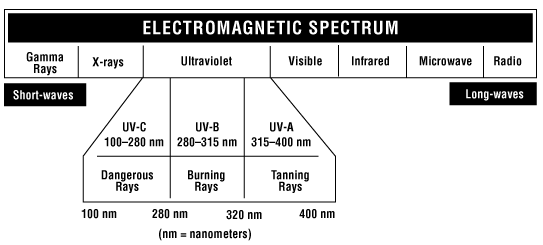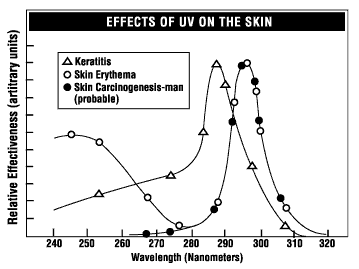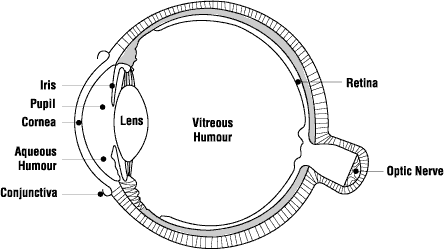Ultra violet radiation :
Ultraviolet (UV) radiation is similar to visible light in all physical aspects, except that it does not enable us to see things. The light that enables us to see things is referred to as visible light and is composed of the colors we see in a rainbow. The ultraviolet region starts right after the violet end of the rainbow.
In scientific terms, UV radiation is electromagnetic radiation just like visible light, radar signals and radio broadcast signals (see Figure 1). Electromagnetic radiation is transmitted in the form of waves. The waves can be described by their wavelength or frequency and their amplitude (the strength or intensity of the wave). Wavelength is the length of one complete wave cycle. For radiation in the UV region of the spectrum, wavelengths are measured in nanometers (nm), where 1 nm = one millionth of a millimeter.
Different wavelengths of electromagnetic radiation cause different types of effects on people. For example, gamma rays are used in cancer therapy to kill cancerous cells and infrared light can be used to keep you warm.
UV radiation has shorter wavelengths (higher frequencies) compared to visible light but have longer wavelengths (lower frequencies) compared to X-rays. UV radiation is divided into three wavelength ranges:

Figure 1 - Electromagnetic spectrum
What are some sources of ultraviolet radiation:
Sunlight is the greatest source of UV radiation. Man-made ultraviolet sources include several types of UV lamps, arc welding, and mercury vapor lamps.
UV radiation is widely used in industrial processes and in medical and dental practices for a variety of purposes, such as killing bacteria, creating fluorescent effects, curing inks and resins, phototherapy and suntanning. Different UV wavelengths and intensities are used for different purposes.
Table 1 gives some examples of occupations with a potential risk of ultraviolet exposure. Table 2 gives examples of devices which employ UV radiation.
Table 1
Workers at Potential Risk from Exposure to UV Radiation
Health effects of exposure to UV radiation:
Some UV exposure is essential for good health. It stimulates vitamin D production in the body. In medical practice, UV lamps are used for treating psoriasis (a condition causing itchy, scaly red patches on the skin) and for treating jaundice in new born babies.
Excessive exposure to ultraviolet radiation is associated with different types of skin cancer, sunburn, accelerated skin aging, as well as cataracts and other eye diseases. The severity of the effect depends on the wavelength (see Figure 2), intensity, and duration of exposure.
Effect on the skin:
The shortwave UV radiation (UV-C) poses the maximum risk. The sun emits UV-C but it is absorbed in the ozone layer of the atmosphere before reaching the earth. Therefore, UV-C from the sun does not affect people. Some man-made UV sources also emit UV-C. However, the regulations concerning such sources restrict the UV-C intensity to a minimal level and may have requirements to install special guards or shields and interlocks to prevent exposure to the UV.
The medium wave UV (UV-B) causes skin burns, erythema (reddening of the skin) and darkening of the skin. Prolonged exposures increase the risk of skin cancer.

Figure 2 - Relative sensitivity of the eye and the
skin to UV radiation of different wavelengths.
Longwave UV radiation (UV-A) accounts for up to 95% of the UV radiation that reaches the earth's surface. Although UV-A is less intense than UV-B, it is more prevalent and can penetrate deeper into the skin layers, affecting the connective tissue and blood vessels, which results in premature aging.
Certain chemicals and medications act as photosensitizing agents and enhance the effect of UV radiation form sunlight or other sources. Such agents include thiazide diuretics (drugs which cause excessive urine production), drugs used in the treatment of high blood pressure, certain antibiotics (tetracyclines, sulfonamides), cosmetics, and thiazine tranquilizers.
These are just a few examples; this is not intended to be a comprehensive list. However, it is important to know that these photosensitizing effects can occur in case people are exposed to UV radiation at work. For example, an inexperienced welder, who was taking a phenothiazine anti-depressant drug, suffered damage in both eyes in the part of the retina that absorbs short wavelength light (bilateral maculopathy). He began complaining of eye problems a day after he was arc welding for two minutes without wearing any eye protection. This damage, that fortunately was reversible after several months, occurred because the drug he was taking sensitized him to the UV radiation to which he was exposed.
Various plants such as carrot, celery, dill, fig, lemon and some types of weeds are known to cause photosensitivity. Exposure to fluids from these plants, especially if crushed, followed by exposure to sunlight can cause dermatitis. Citrus fruit handlers and vegetable harvesters, gardeners, florists and bartenders are at risk for experiencing dermatitis following exposure to certain plants and then to sunlight (phytophotodermatitis).
Coal tar and creosote are examples of photosensitizing agents in the workplace.
Effects of repeated exposures (chronic effects) include skin aging and skin cancer. There is a strong causal link between skin cancer and prolonged exposure to solar UV and from artificial sources.
Effect on the eyes:
The eyes are particularly sensitive to UV radiation. Even a short exposure of a few seconds can result in a painful, but temporary condition known as photokeratitis and conjunctivitis. Photokeratitis is a painful condition caused by the inflammation of the cornea of the eye. The eye waters and vision is blurred. Conjunctivitis is the inflammation of the conjunctiva (the membrane that covers the inside of the eyelids and the sclera, the white part of the eyeball); (see Figure 3) which becomes swollen and produces a watery discharge. It causes discomfort rather than pain and does not usually affect vision.

Figure 3 - The eye
Examples of eye disorders resulting from UV exposure include "flash burn", "ground-glass eye ball", "welder's flash" and "snow blindness" - depending on the source of the UV light causing the injury. The symptoms are pain, discomfort similar to the feeling of sand in the eye and an aversion to bright light.
The eyes are most sensitive to UV radiation from 210 nm to 320 nm (UV-C and UV-B). Maximum absorption by the cornea occurs around 280 nm. Absorption of UV-A in the lens may be a factor in producing cataract (a clouding of the lens in the eye).
Occupational exposure limits?
There are no Canadian regulatory occupational exposure limits for UV radiation. Many jurisdictions follow the limits recommended by the American Conference of Governmental Industrial Hygienists (ACGIH). These limits are given below:
1. For the UV-A or near ultraviolet spectral region (315 to 400 nm), exposure to the eye should not exceed 1 milliwatt per square centimeter (1.0 mW/cm2) for periods greater than 1000 seconds (approximately 16 minutes). For exposure times less than 1000 seconds, the dose (total energy) should not exceed 1.0 J/cm2. Additional exposure limits apply to the amount of UV light exposure to the skin and the eyes. The amount of UV exposure a person can receive on their skin or eyes during an 8-hour period varies with the wavelength of the UV radiation. For specifics, you can consult the Ultraviolet Radiation section of the current edition of the ACGIH publication Threshold Limit Values for Chemical Substances and Physical Agents and Biological Exposure Indices®.
2. For the actinic ultraviolet spectral region (200-315 nm; about half of the UV-C and most of the UV-B range), see the TLVs referred to in the current TLV booklet published by ACGIH.
How do you protect yourself from UV radiation:
UV radiation is invisible and therefore does not stimulate the natural defenses of the eyes. Workers must use eye and skin protection while working with UV radiation sources which present the potential of eye harmful exposure. The selection of eye protection depends on the type and intensity of the UV source. For more information consult CSA Standard (CAN/CSA-Z94.3-07 (R2012) Eye and Face Protectors. UV radiation is easily absorbed in a variety of materials. Shielding is usually easy to design. Mercury lamps and metal halide lamps have an outer glass cover to stop UV radiation, and are designed such that if the outer glass is broken, the lamp ceases to function.
How does the ozone layer affect your exposure to UV radiation from the sun:
Certain industrial chemical pollutants in the atmosphere are gradually eroding earth's protective shield (ozone layer) which stops the sun's UV radiation from reaching the earth. In recent years, there has been growing concern about increasing levels of UV radiation in the sunlight, especially during the summer months. Excessive exposure to ultraviolet rays can cause skin cancer and eye cataracts.
What can you do to protect yourself from UV radiation from the sun:
Ways to limit exposure to the sun's UV radiation include avoiding working in the sun, wearing protective clothing and hats, and applying sunscreens.
Protective clothing can include long pants, hats, and long-sleeved shirts. Some newer, sun-resistant fabrics are more efficient in blocking UV radiation.
Physical sunscreens (e.g., zinc oxide and titanium dioxide) are opaque products that reflect or block both UVA and UVB. Chemical sunscreens are non-opaque (i.e., you can see through them on your skin). They absorb UVA, UVB, or both. Wide spectrum sunscreens are intended to block both types of UV radiation.
Sunscreens are rated according to Sun Protection Factor (SPF), an index of protection against skin erythema (reddening of the skin). SPF ranges from 1-50 or more. The higher the SPF is, the more protection it offers from UVB radiation.
- SPF 15 sunscreen may absorb more than 92 percent of UVB radiation
- SPF 30 sunscreen may absorb 96.7 percent
- SPF 40 sunscreen may absorb 97.5 percent of UVB radiation
We hear on the radio and read in the newspapers about the UV index as a part of the weather forecast. The UV index is a measure of the intensity of UV radiation in the sunlight that causes reddening of the skin (erythema). The UV index scale runs from 0 (when there is no sunlight) to 11+ (extreme). The UV index can increase the mid-teens at midday in the tropics. The implications of the UV index are summarized in Table 3.